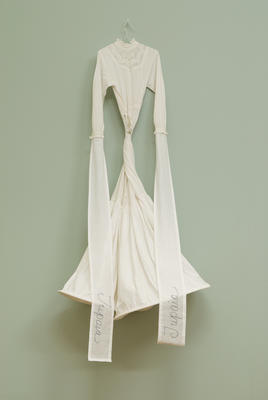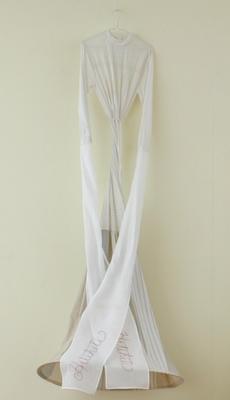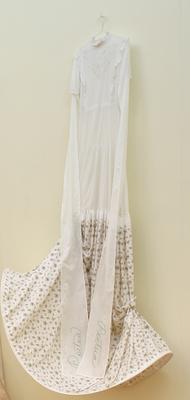Tall Tahitians - Tu
Christine Hellyar, Artist
This is one of the
installations
in our collection.
It was made in
Whanganui Region, New Zealand
in 2005.
See full details
Object Detail
About the Work
"The
Pacific
has
stereotypically
been
associated
with
hula
dancing
dusky
maidens.
Hellyar
references
this
in
the
Tall
Tahitians
a
suite
of
adapted
white
Victorian
style
dresses.
Found
in
an
Auckland
antique
shop
these
are
similar
to
the
garments
that
Cook
brought
with
him
to
give
to
the
Polynesians,
these
were
unsuitable
for
the
big
boned
Tahitians,
Hellyar
has
extended
these
and
given
them
a
sense
of
swaying
hula
hips
by
incorporating
bamboo
hoops
at
the
base
of
each
garment.
The
names
on
each
dress
are
those
of
Tahitian
chiefs
that
Cook
met,
some
of
whom
were
taken
back
to
Britain
as
curios,
most
notably
Mai,
or
Omai.
The
extended
arms
are
folded
across
each
other
so
as
to
resemble
Bishops
stoles.
By
embroidering
the
names
of
men
on
‘female’
garments
Hellyar
questions
gender
roles.
The
Painters
Nets
–
whilst
painting
in
the
Pacific
the
artists
had
to
paint
under
nets
as
bugs
would
eat
the
paint
as
it
was
applied
to
the
canvas"
Greg
Donson,
exhibition
notes
for
"Cooks
Garden"
exhibition
2005.
Christine Hellyar, 3 June 2012 – "Tall Tahitians came from my reading lots of different journals from Capt Cook's voyages. Tahitians men and women were taller and more athletic than Cook's men, and the dresses they were given as trade items would have been too small; they were also given lengths of cloth so I like to think that there additions were made. Also a larger amount of cloth gave status to the wearer the additions would increase their social standing. I tried to use cloth that would have been attractive to Tahitians.The embroidery relates to names tattooed on people's arms...a dubious practice? Embroidery itself in European eyes increased status, of course.Cane was found in the Western Pacific so I used cane in the bottoms of the dresses to make them swing more and also look more like flowers."
Christine Hellyar, 3 June 2012 – "Tall Tahitians came from my reading lots of different journals from Capt Cook's voyages. Tahitians men and women were taller and more athletic than Cook's men, and the dresses they were given as trade items would have been too small; they were also given lengths of cloth so I like to think that there additions were made. Also a larger amount of cloth gave status to the wearer the additions would increase their social standing. I tried to use cloth that would have been attractive to Tahitians.The embroidery relates to names tattooed on people's arms...a dubious practice? Embroidery itself in European eyes increased status, of course.Cane was found in the Western Pacific so I used cane in the bottoms of the dresses to make them swing more and also look more like flowers."
This record has related works.
Measurements
H2865 x W810 x D750
Media
linen with embroidery and cane support
Description
White linen gown with a collar and tucked embroidered design, the garment is elongated to nearly 3 metres tall. It hangs on the wall using a wire hanger. The skirt is made from cream printed fabric and the hem has a cane hoop inserted that makes it hang away from the wall. The sleeves are elongated with inserted rectangular strips of linen resembling bishops stoles, the ends of the stoles have the name of the Tahitian chief Tu embroidered in dark thread.
Credit Line
Collection of the Sarjeant Gallery Te Whare o Rehua Whanganui. Gift of the artist, 2012
Collection Type
Permanent collection
Acquisition Date
Mar 2012
Share
Artist:
Nationality:
Accession Number:
2012/1/2








